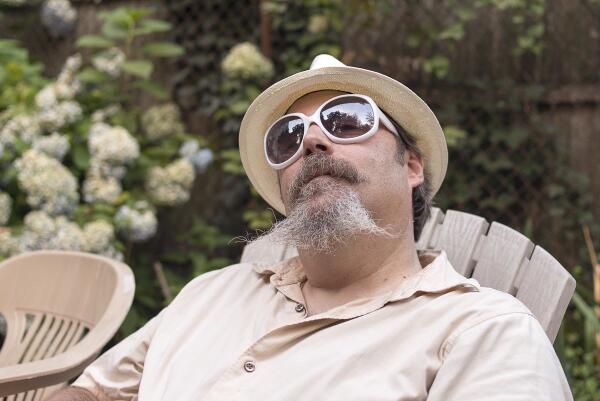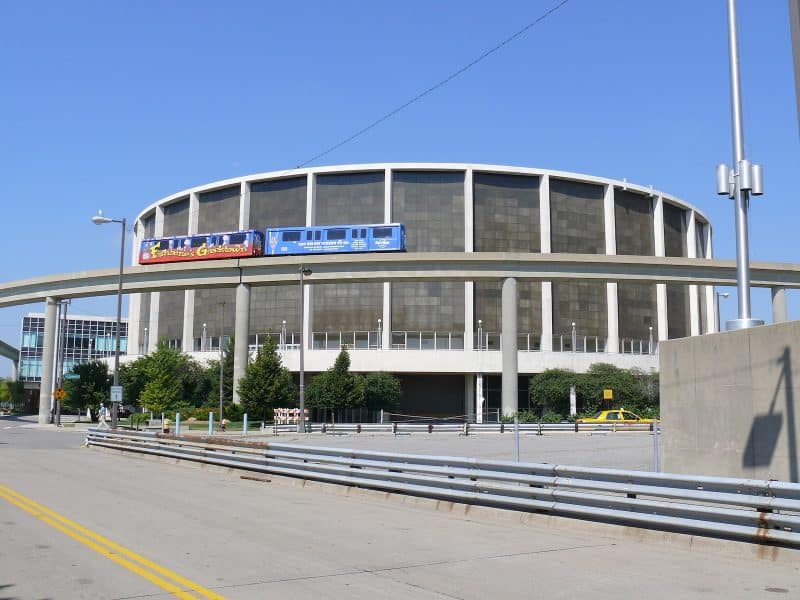Dive bars, cocktails, and the soul of a city: A conversation with “mixographer” David Wondrich
Cocktail historian David Wondrich recently named Detroit "Bar City of the Year" in Esquire magazine. He sat down with Model D and talked about how Midwest cities are "much more alive than people in New York and San Francisco give them credit for" and why "bars without old people in them are boring."

New York author and cocktail historian David Wondrich is at the center of the resurgent American cocktail movement. His book “Imbibe!” is widely regarded as one of its foundational texts. As a correspondent for Esquire magazine, he’s chronicled the rise of the mixed drink in America. Along the way, he’s become an expert on the world’s most cutting-edge cocktail lounges while championing the fraternal collectivism that makes community spaces vibrant. He’s not an urban planning expert; rather, he’s an expert on how people interact in urban spaces.
This month, Esquire dubbed Detroit “Bar City of the Year.” Model D’s John Notarianni called up Mr. Wondrich to discuss his visit to Detroit, his personal experience with the pitfalls of gentrification, and the future of Detroit’s ascendant drinking and dining scene.
Detroit: Bar City of the Year
John Notarianni: You chose to feature Detroit as Esquire’s ‘Bar City of the Year.’ What is it that appealed to you about the culture of this city?
David Wondrich: When you tell people in New York that you’re visiting Detroit, everyone’s like, “Why would you go there?” They just really don’t get it. They think this place is just like something out of “Mad Max”: deserted and empty and abandoned. But you go to Detroit and there’s a lot of life. Bars are central to that. Bars are meeting places; they’re stress relievers. They’re a really good place to get a sense of the energy of a town.
The bars in Detroit were very lively. It’s similar in Milwaukee and Cincinnati and Cleveland: all those cities are much more alive than people in New York and San Francisco give them credit for. They’re more alive in some ways than Manhattan, which is very interesting to me.
JN: How do you mean?
DW: In Manhattan, they’re sliding into a monoculture. It’s very prosperous and everything else is being sacrificed to that. There are great cocktail bars in New York because there’s the financing for it, but the owners are not the people who are working there, for the most part. Then you go into a bar in Detroit and you see that there are older people there, there are younger people there. You can still run a family business. It’s not going to be developed out from under you like what’s happened to bar after bar in New York. So many of the old bars have closed in Manhattan. That’s coming to Brooklyn, too, and it’s really sad. There used to be neighborhood places where people from all walks of life would be in there. I find bars without old people in them to be boring because there’s nobody in there to talk to.
JN: One of the places you seemed very excited about in your article was the Old Miami, an old veterans bar in the Cass Corridor. What do older places like that offer to a city?
DW: (Laughter) well that’s what we’ve lost in New York, you know? It pains me to see that go. Those are real places of education and of generational transfer of knowledge and wisdom. The new stuff is great, too — you’ve got to have both — but I hate it when the new comes at the expense of the old. Detroit has an opportunity now because it’s so un-dense. Some of this old stuff can still stay around; it’s not like suddenly all the property values around it are going to shoot up and these old businesses will get torn down and replaced by a bank.
In Defense of Hipsters
JN: You wrote an article in Esquire last year charting the changes in your neighborhood in Brooklyn. It sounds like you’ve seen the full life cycle of urban gentrification.
DW: Yeah, I’ve been in the same house in Brooklyn since 1986. When I moved in, there were hookers on my block. Cab drivers wouldn’t take us there. It seemed far from civilized New York. It took my girlfriend and me a long time to come to grips with the place. We wanted to move into Manhattan but couldn’t afford it. But over the course of years we came to appreciate what was there in front of us, the local culture.
At the same time, other people like us started opening businesses. They were filling up empty storefronts, not kicking anyone out; they were filling in the neighborhood, not changing it. That first wave of gentrifiers was pretty benign. But that of course drove up property values and drove up rent and some of the old stuff started closing.
For a long time there was enough of the old stuff left that it wasn’t much of a problem. Eventually, though, it got to the point where they were not just kicking out businesses, they would kick them out and then tear the building down. That was different from the hipsters: the hipsters were always very respectful of the physical space. They were renovators, not constructors. Now we’ve got the developers coming in and it’s looking like we’ll never be able to go back to having a balanced neighborhood with more prosperous and less prosperous people, old and young, families and old men.
JN: Do you see neighborhoods in Detroit going through a similar life cycle?
DW: In Corktown I saw the “let’s fix up empty businesses, let’s revitalize the neighborhood, let’s not destroy it” attitude. But it also looks like there’s a lot of failed urban development downtown. And the problem with that is that they tore down so much that it’s hard to recover. Indianapolis is also a very good example of that, where downtown is all parking lots. You can walk in Indianapolis for 45 minutes until you see a pharmacy. People a generation ago saw these downtowns and didn’t see them as an opportunity. They saw them as a problem and needed somewhere to park because they were living in the suburbs, so they said ‘lets tear it down, build a parking lot and it will be fine.’ It’s not fine.
Detroit’s New Blood
JN: Detroit’s experiencing a surge of new bars and restaurants planning to open in the next year: Wright and Company, Rose’s Fine Food, Gold Cash Gold, HopCat, and many more. What does a new bar need to do to survive?
DW: You need to be flexible. You move into a neighborhood, you’ve got a business plan, and suddenly you’re attracting different people than who you were planning for. You can either embrace them or say no, I’m going to stubbornly insist on going after this one style of bar. I think it’s really feeling like you belong to the neighborhood and treating that neighborhood like it’s your home. When I think the most successful bars I’ve seen — the ones that have found longevity — I think of Clover Club in Brooklyn that was going to be opened as a destination craft cocktail bar and it’s now the greatest neighborhood bar.
JN: What advantages do you see for new a bar that’s opening in Detroit?
DW: I talk to a lot of young people around the country and a lot of people are thinking, “You know, I could go to Detroit and I could get a building and I could actually start a business,” and that is extremely exciting. It’s so hard to open a business in New York, for instance. You need a lot of money. For that, you need partners. And those partners are going to be money guys and they’re going to want to drive the business one way. A place where you can have that freedom to open it up and do something your own way — I saw that at the bars in Detroit: The Oakland and The Sugar House; they seem to be doing it. I saw PJ’s Lager House, a unique place. It looks like this young takeover of an old neighborhood bar, but it’s still a neighborhood bar and they’re still doing their own thing. I thought that was very cool.
JN: One of the things you said in your article about the Oakland in Ferndale is that a city needs ‘new blood;’ otherwise it’s only playing defense.
DW: You can’t JUST preserve the old. You need new businesses; you need new approaches. The Oakland and the Sugar House are national-grade, state of the art, modern cocktail bars. It’s cool to see them there. They’re not kind of half-assing it; they’re doing it right.
JN: At the same time, though, you seem convinced that a city needs to preserve its neighborhood dives alongside newer, flashier restaurants. It seems like you have a sense of loss about the Brooklyn of the ’80s. Why do those relics of the past go away, and what do we lose?
DW: These things go away because of market forces. You want market forces, but they’re very undiscriminating. We lost a lot in Brooklyn near me. There’s only one of our Old Miami’s left, a true neighborhood dive, and the building is up for sale. The bartender’s been there 25 years. It used to be a Mohawk ironworkers bar. There are old guys in there and civil servants who go there to drink their lunch, but you get to talking with them and they really know the history of the city. When they go, you’re just left with yuppie bars.
JN: So when you’re back in New York and you’re telling your friends about your time in Detroit, what’s the one bar moment you would recount to summarize your time in Detroit?
DW: I loved how when I was at the Sugar House, half the bar staff left their shift and came with us over to the Bronx Bar, just because they could. That was cool. That’s like this casual “alright, we’re open but it’s kind of quiet — we’ll leave a couple bartenders here.” You can’t do that in New York. There’s not that sense of freedom. Everybody’s so driven by the bottom line because the bottom line is such a heavy responsibility.
JN: And the best drink you had?
DW: (Pause) Actually, it was the beer I had the next day (laughter). I had a pint of Motor City Ghetto Blaster while hung-over. Very good.
Dave Wondrich is a cocktail historian and author of several books including Imbibe!: From Absinthe Cocktail to Whiskey Smash, a Salute in Stories and Drinks to “Professor” Jerry Thomas, Pioneer of the American Bar, and a regular correspondent for Esquire Magazine. His article “Detroit: Bar City of the Year” is available in the June/July print edition of Esquire Magazine.
John Notarianni is a Detroit-based writer and semi-retired mixologist.





